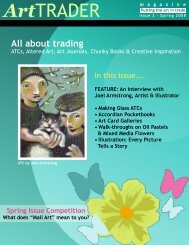Beginner's - ArtTrader Magazine
Beginner's - ArtTrader Magazine
Beginner's - ArtTrader Magazine
Create successful ePaper yourself
Turn your PDF publications into a flip-book with our unique Google optimized e-Paper software.
Art TRADER<br />
m a g a z i n e<br />
Step 5: The fine details<br />
Now add in fur - density and markings. Look for the direction in which it runs and distinctive patterning.<br />
Don’t forget the hair in the ears! Hair can be depicted in a series of strokes - long extended “V”s for long<br />
furred creatures and neck ruffs/manes, short “l”s for short furred creatures or just a flat coour for the<br />
very short furred animals, like horses. Also note that most mammals have whiskers. These are more<br />
pronounced in the smaller prey animals, but even large ones like horses have bristles about their lips<br />
and nostrils. DO NOT feel you have to draw EVERY single whisker. About 3-5 on each side should be<br />
sufficient. Gel pens work well for whiskers - try silver or white (on dark-furred animals).<br />
Color<br />
If using coloring pencils, choose a range of colours. Most animals have a range of shading in their<br />
fur - especially brown or grey ones. Note: these colors pertain to the Faber-Castell Polychromos, my<br />
preferred pencils. You can find the chart of colors here: http://www.faber-castell.de/ (under “color<br />
chart”).<br />
Black<br />
Black, purple or indigo,<br />
dark (paynes) grey, medium<br />
grey, light purple or blue for<br />
highlights.<br />
Grey<br />
Light grey, medium grey, dark grey,<br />
black. Use indigo for added emphasis<br />
of shadows. A light blue-grey can be<br />
useful but use it carefully and don’t<br />
get into the bright blues.<br />
-62-<br />
White<br />
White, ivory, cream or pale<br />
blue, light grey. Be careful<br />
about overdoing the blues.




